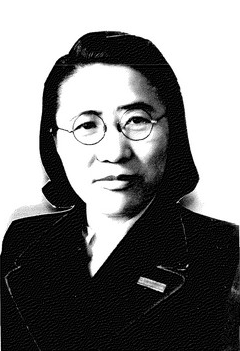Ho Jong-suk facts for kids
Quick facts for kids
Ho Jong-suk
|
|
|---|---|

Ho in 1945
|
|
| Chief Justice of the People's Supreme Court |
|
| 2nd term | |
| In office 28 October 1959 – 24 June 1960 |
|
| Preceded by | Kim Ha-un |
| Succeeded by | Kim Ik-son |
| Minister of Justice | |
| 2nd term | |
| In office 18 September 1957 – 31 August 1959 |
|
| Premier | Kim Il-sung |
| Succeeded by | Post abolished |
| 1st term | |
| In office 3 August 1957 – 18 September 1957 |
|
| Premier | Kim Il-sung |
| Preceded by | Hong Ki-ju |
| Minister of Culture and Propaganda | |
| 1st term | |
| In office 9 September 1948 – 3 August 1957 |
|
| Premier | Kim Il-sung |
| Preceded by | Post established |
| Succeeded by | Han Sol-ya as Minister of Education and Culture |
| Personal details | |
| Born |
Ho Jong-ja
July 16, 1908 Seoul, Korea |
| Died | June 5, 1991 (aged 82) Pyongyang, North Korea |
| Political party | Workers' Party of Korea |
| Parent |
|
| Occupation | Politician, activist |
| Korean name | |
| Chosŏn'gŭl |
허정숙
|
| Hancha | |
| Revised Romanization | Heo Jeongsuk |
| McCune–Reischauer | Hŏ Chŏngsuk |
| Courtesy name | |
| Chosŏn'gŭl |
정자
|
| Hancha | |
| Revised Romanization | Jeongja |
| McCune–Reischauer | Chŏngja |
Ho Jong-suk (Korean: 허정숙; Hancha: 許貞淑; RR: Heo Jeong-suk; MR: Hŏ Chŏng-suk; July 16, 1908 – June 5, 1991) was an important female leader in the Communist Party of Korea. She was active during the time Japan ruled Korea. After 1948, she held many important jobs in North Korea. These included being the Minister of Health and the Chief Justice of the Supreme Court of North Korea.
Contents
Early Life and Education
Ho Jong-suk was born on July 16, 1908, in Seoul, Korea. Her birth name was Ho Jong-ja. Her father was a well-known person named Ho Hon.
When she was young, Ho Jong-suk traveled to Japan to study at Kwansei School in Tokyo. Later, she moved to the Shanghai International Settlement in China. There, she attended and graduated from Shanghai Foreign High School. After her studies, she returned to her home country.
Becoming an Activist
In 1921, Ho Jong-suk became involved in the women's movement in Korea. She also joined the Korean Communist Party. At that time, the Japanese government that ruled Korea made the Communist Party illegal. Ho Jong-suk managed to avoid being arrested for her involvement.
In 1924, she learned about International Women's Day. The next year, in March 1925, she attended a Women's Day event in Seoul. She continued her activism. In 1927, she helped start an organization called Geunwoohoi. She also took part in another group called Singanhoe (신간회).
Some of her ideas were very modern for her time. They were not always popular in Korean society. This was because old traditions from Confucianism were still very strong in Korea.
Fighting for Independence
In 1936, Ho Jong-suk went to China. There, she joined the Korean National Revolutionary Party (조선민족혁명당). This group was working for Korea's independence. In 1938, she moved to Hebei, a region in China. She joined Chosen Independence alliance, which was a Korean resistance group fighting against Japan.
When Korea was freed from Japanese rule in 1945, she returned to Seoul. However, she soon moved to North Korea. She did this to stay safe from political dangers at the time.
Roles in North Korea
In 1948, Ho Jong-suk became part of the new North Korean government. She held several important positions:
- She served as the Minister of Culture from 1948 to 1957.
- She became the Minister of Justice in 1957.
- From October 28, 1959, to 1960, she was the Chief Justice of the Supreme Court of North Korea. This made her a top judge in the country.
Ho Jong-suk passed away on June 5, 1991, in Pyongyang, North Korea.
See also
 In Spanish: Ho Jong-suk para niños
In Spanish: Ho Jong-suk para niños

